Future Now
The IFTF Blog
Legends In VR
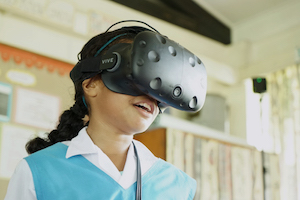
A student from Stella Maris Primary School in
Fiji tests the BTS VR experience.
Over the past months, IFTF researchers Quinault Childs and Toshi Hoo of the Emerging Media Lab (EML) have been involved in advising an exciting project - SecondMuse’s Legends - that explores storytelling and virtual reality for nutritional behavior change. The EML is IFTF’s research lab focusing on how new media technologies will change the way we work, play, and behave, and Legends is one of the cutting edge projects that is actively bringing this future into the present.
Davar Ardalan recently interviewed Tash Tan - a Virtual Reality designer - about the project that he is leading under the purview of Legends. His combination VR experience/game-forward school curriculum called Beyond the Stars is gearing up for its debut in Fiji next month.
Read on for Davar and Tash’s insights on what makes this project stand out as a step forward in experiential learning and nutritional improvement.
Davar Ardalan is the founder and storyteller in chief of IVOW. She was formerly the director of Storytelling and Engagement at SecondMuse and an award-winning journalist for National Public Radio.
Beyond The Stars (BTS), an immersive storytelling project, will be showcased next month across nine schools in the island nation of Fiji. Funded by the Australian Government Department of Foreign Affairs and Trade’s innovationXchange (DFAT iXc), and produced by Sydney-based creative technology agency S1T2 (Story 1st, Technology 2nd) together with SecondMuse, the pilot program is geared towards tackling malnutrition and restoring people’s pride in traditional diets via VR and gamification.
“From the outset, we've worked closely with educators, cultural advisors, and local artists to ensure the program is very much a product of Fiji for Fiji,” says Allan Soutaris, director of the Legends project, which includes Beyond the Stars. “We consider those stakeholders as co-creators and owners of the program, and their input has informed key elements of the narrative, structure, and classroom delivery. Without the valuable insight provided by schools and communities, I don't believe the program would resonate nearly as much has it has so far. There is a real sense of magic to the narrative that could have only come from an approach such as this.”
Tash Tan is one of the founding partners of creative technology agency S1T2, and its head of Digital & Interactivity. Tash specialises in user experience, creative design and digital strategy.
1. Tell us about the genesis of Beyond the Stars.
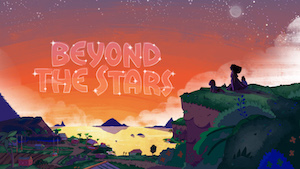
Beyond the Stars is an educational game that
uses storytelling and interactive technologies.
In the Pacific Islands, noncommunicable diseases (NCDs) are the leading cause of death. Cheap, imported, nutrition-poor foods including instant noodles and sugary drinks are having a negative impact on traditional diets, and are linked to devastating levels of diabetes, heart disease, amputation, and even death. It’s important to note that many of these NCD-related issues are preventable.
In October 2016, a hackathon was held at the Australian Government Department of Foreign Affairs and Trade’s innovationXchange in Canberra. Building on ideas that emerged from the hack, S1T2 put forward a solution called Beyond the Stars that proposed to utilize storytelling enriched by new technology to fight the ‘NCD Crisis’ by inspiring children in the Pacific to adopt healthy living habits and rekindle their passion for their own tradition and culinary heritage.
When you travel to the Pacific Islands and see for yourself what effect NCDs have on the region, you cannot help but feel a sense of responsibility and leave with a desire to do whatever you can to change the situation. And, contrary to the lack of progress being made to combat NCDs directly, improvements in technology infrastructure and bandwidth within certain countries in the Pacific -- such as Fiji, where our pilot is based -- present a unique opportunity to use technology as the impetus for change.
2. How has the community of teachers and students responded so far to BTS?
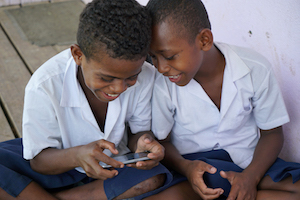
Students from Waiqanake Primary School
in Fiji playing the BTS mobile game.
Teachers and students have been equally excited about the program as it is something that is as much a first for Fiji as it is a world-first. The way the program directly incorporates aspects of the school curriculum and national policies into the interactive story means that motivating children to learn is simple and effective. In a similar manner that Star Wars and Harry Potter share their characters, stories, and universes over multiple mediums, we use transmedia storytelling to imbue a sense of wonder in all our platforms from the immersive cutting-edge to the accessible low-fi.
The play-based learning tools that are being supplied as part of the program are also a significant improvement on prior teaching methods. From initial reports and evaluations, we’ve found that this approach is proving to be immensely rewarding even in an educational context as children are not only able to articulate the narrative of Beyond the Stars, they are also able to demonstrate an understanding of the program learnings and impact outcomes behind the narrative.
3. Share some of the key VR techniques, and what the response has been from students.
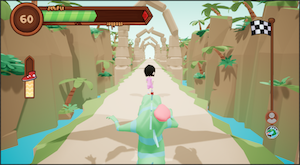
Mini games are used to teach children
curriculum and national policies.
One of the key VR storytelling elements we have introduced into the VR narrative is Masi -- a flying tapa cloth. Masi is the companion that guides our heroes on their VR journey. He is a bit cheeky and likes to play games with our hero. In one scene, for example, Masi imitates your movements accentuating your agency over the world. This in some ways makes the fictional world feel more real -- you are the protagonist who has a reciprocal relationship with the characters in VR.
Another exciting aspect is the blurring of fiction and reality. In the final scene, a book is revealed in VR which is the last thing you see before you take off the headset. After removing the headset, each child is given their own Beyond the Stars book, transposing the magic of the virtual world into that object. This book then becomes their compendium for the story universe, and is something they can cherish and keep long after the VR experience.
4. How do you hope BTS will inspire action in students and bring back pride in tradition and healthier diets?
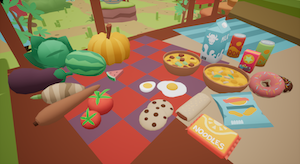
Food found in Fiji will be modeled into
the game world.
We believe that action starts with empowerment. In this sense, we are using technology to enrich our story by allowing the story world to be interactive. Through this, each child becomes a story-maker or storyteller of their own. They are not just watching characters, but living and experiencing the universe for themselves.
In this virtual interactive story, children have the chance to try, and try again in a safe environment, but also to reach the realization that everyone has the power to make a difference. This application of gamification methodology is essential to teaching healthy living because we are faced with decisions and choices every day on what to eat, how to live our lives, and our adoption of local tradition and culture.
Related Links:
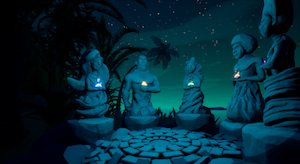
The VR experience takes children into a
magical cave where they discover
the magic of the guardians.
You can read more about our project here:



